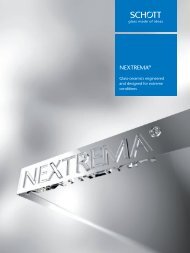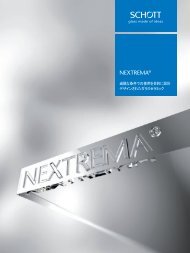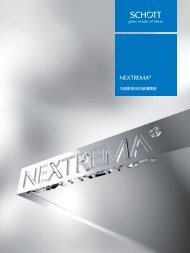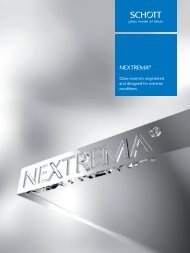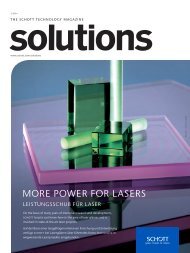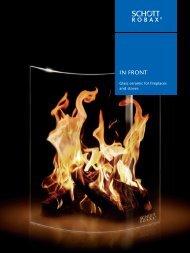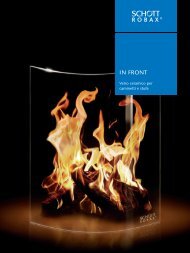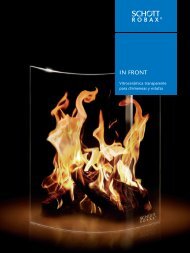SCHOTT Technical Glasses
Apart from its application in optics, glass as a technical material has exerted a formative influence on the development of important technological fields such as chemistry, pharmaceutics, automotive, optics, optoelectronics and information technology. SCHOTT Technical Glasses offers pertinent information in concise form. It contains general information for the determination and evaluation of important glass properties and also informs about specific chemical and physical characteristics and possible applications of the commercial technical glasses produced by SCHOTT. With this brochure, we hope to assist scientists, engineers, and designers in making the appropriate choice and make optimum use of SCHOTT products.
Apart from its application in optics, glass as a technical material has exerted a formative influence on the development of important technological fields such as chemistry, pharmaceutics, automotive, optics, optoelectronics and information technology. SCHOTT Technical Glasses offers pertinent information in concise form. It contains general information for the determination and evaluation of important glass properties and also informs about specific chemical and physical characteristics and possible applications of the commercial technical glasses produced by SCHOTT. With this brochure, we hope to assist scientists, engineers, and designers in making the appropriate choice and make optimum use of SCHOTT products.
You also want an ePaper? Increase the reach of your titles
YUMPU automatically turns print PDFs into web optimized ePapers that Google loves.
9<br />
Weight loss after 3 h in mg/100 cm 2 ––><br />
50<br />
40<br />
30<br />
20<br />
10<br />
0<br />
0 8 10 12 14<br />
ph ––><br />
Fig. 2. Alkali attack on DURAN ® /BOROFLOAT ® 33/SUPREMAX ®<br />
related to pH value at 100 °C<br />
Because acid and alkali attacks on glass are fundamentally<br />
different, silica-gel layers produced by acid attack ob viously<br />
are not necessarily effective against alkali solutions and may<br />
be destroyed. Conversely, the presence of ions that inhibit<br />
an alkali attack does not necessarily represent protection<br />
against acids and water. The most severe chemical exposure<br />
is therefore the alternating treatment with acids and alkaline<br />
solutions. As in all chemical reactions, the intensity of<br />
interaction increases rapidly with increasing temperature<br />
(Figures 27 and 28).<br />
In the case of truly ablative solutions such as hydrofluoric<br />
acid, alkaline solutions, or hot concentrated phosphoric<br />
acid, the rate of attack increases rapidly with increasing<br />
concentration (Figure 2). As can be seen in Figure 3, this is<br />
different for the other frequently applied acids.<br />
2<br />
0.03<br />
HCI Temperature: 100 °C<br />
Time: 1 h<br />
2.2 Determination of chemical stability<br />
Attacked layer in µm ––><br />
0.02<br />
0.01<br />
CH 3 COOH<br />
H 2 SO 4<br />
HNO 3<br />
0.00<br />
0 5 10 15 20<br />
Acid concentration (molarity) ––><br />
Fig. 3. Acid attack on DURAN ® /BOROFLOAT ® 33/SUPREMAX ®<br />
as a function of concentration<br />
In the course of time, many analysis methods have been<br />
suggested for determining the chemical stability of glass. In<br />
most cases, it is the glass surface that is analyzed either in its<br />
“as delivered” condition (with the original fire-polished surface)<br />
or as a basic material with its fire-polished surface removed<br />
by mechanical or chemical ablation, or after crushing.<br />
The standardized DIN* test methods, which are uni versally<br />
and easily applicable, are the most reliable analysis methods.<br />
They include the determination of hydrolytic resistance<br />
(by two grain-titration methods and one surface method),<br />
of acid resistance to hydro chloric acid, and of alkali resistance<br />
to a mixture of alkaline solutions.<br />
Hydrolytic<br />
classes<br />
Acid consumption of 0.01 mol/l<br />
hydrocholric acid per g glass grains<br />
ml/g<br />
Base equivalent as Na 2 O<br />
per g glass grains<br />
µg/g<br />
Possible designation<br />
1 up to 0.10 up to 31 very highly resistant glass<br />
2 above 0.10 up to 0.20 above 31 up to 62 highly resistant glass<br />
3 above 0.20 up to 0.85 above 62 up to 264 medium resistant glass<br />
4 above 0.85 up to 2.0 above 264 up to 620 low resistant glass<br />
5 above 2.0 up to 3.5 above 620 up to 1085 very low resistant glass<br />
Table 1. Hydrolytic classes of DIN ISO 719<br />
* Deutsches Institut für Normung e. V. German Institute for Standardization






